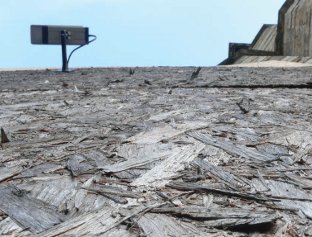Talking about the weather.....
18 July 2013The weather has been a much discussed topic in Europe as the cool, wet spring continues to cause problems for farmers and travellers alike.
The weathering of wood based panels is caused by a number of interacting physical and chemical actions, including: physical damage caused by moisture content fluctuations and impacts from objects in the wind; and chemical breakdown, which is particularly intensified in the presence of light, especially in the UV part of the spectrum.
These effects often increase the possibility of biological attack by moulds and fungi, but I am not going to discuss these this time.
ultra-violet light provides the energy for photochemical reactions that, among other things, change the colour of the wood surface.
Interestingly, darker woods tend to become lighter in colour and lighter coloured woods to darken. All eventually arrive at the characteristic grey colour of weathered wood.
Weathering is primarily light based and so it is a surface phenomenon. The UV light causes depolymerisation of the carbohydrate, particularly lignin, polymers that make up the wood cell wall. The reaction products tend to be more soluble in water and so are leached away from the surface when rain falls on the panel. Consequently, the surface gradually erodes away.
If biological factors are excluded, surface erosion by weathering is slow. It is estimated that, for solid wood, less than 0.5mm is eroded every decade. For wood based panels, especially densified panels, the effects are compounded by shrinking and swelling, which causes a marked roughening of their surfaces. The effects of weathering can be seen quite clearly in Figure 1, which is a vertical shot of a temporary OSB siding that covers restoration work at Lincoln Cathedral in the UK. The surface is grey and rough.
Some strands have distorted markedly, almost being separated from the main panel, while checks, or cracks, can be seen in other strands. Clearly, the surface is very rough compared with the panel when it was first installed. This roughness has a tendency to hold moisture in the panel for longer, thus increasing the risk of attack from moulds and fungi and the length of time in which the adhesive can be hydrolysed.
Removing a grey, weathered strand from the surface would reveal light coloured wood underneath, thus clearly demonstrating how weathering is a surface effect.
The simplest way to mitigate weathering is to apply a coating. Any opaque finish will prevent UV light from attacking the wood underneath. Transparent coatings should include UV absorbers to minimise damage. The coating, especially breathable types, can help keep the moisture content of the panel down and thereby reduce particle swelling. In turn, this helps keep the surface flat and reduces stresses on the coating.
Eventually, however, some water will find its way in and cause enough swelling to fracture the coating, thus allowing even more water in. Everything is eventually weathered to dust - even large mountains - so it is not surprising that wood based panels are affected, too.
Careful design, correct installation and appropriate coatings can prolong the life of panels greatly; even those exposed to a wet European spring.

